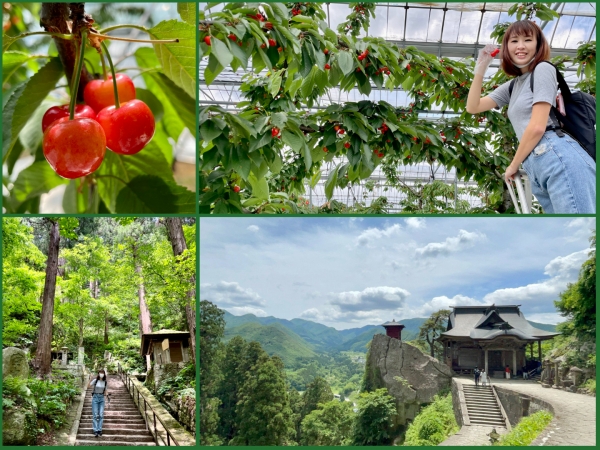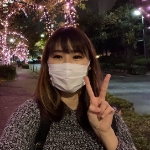Shinryoku season: A jubilant journey to Yamagata Prefecture

Updated as of 08 June 2024
Originally published on 02 July 2022
Before going to Japan, what do you usually plan to see during your trip? For many, it varies from seeing the sakura bloom in spring, the red hues in autumn, or snow in winter. What about the lush greenery during shinryoku season? Shinryoku (新緑), as the name implies, means new green and it is the season where all the new leaves have grown after the cold winter, and right before the sweltering heat in summer.

(Image credit: JR East / Akio Kobori)
Early last month, I had the opportunity to visit Yamagata Prefecture (山形県 Yamagata-ken) to experience shinryoku season. As someone living in a tropical country, greenery is something I am very much used to, however, the fresh green leaves were in shades of green so vibrant, it was nothing like I had seen before! For my day trip in Yamagata, my first stop was to Yamadera Station (山寺駅 Yamadera-eki).
Getting to Yamadera Station

Yamadera Station is designed to resemble a Buddhist temple—very fitting for its location. (Image credit: JR East / Julia Yee)
I began my journey from Sendai Station (仙台駅 Sendai-eki) where I was staying at and took the 8:55am train on the local Senzan Line (仙山線 Senzan-sen). Fun fact: did you know that the Senzan Line got its name from the first kanji of Sendai Station and Yamagata Station (山形駅 Yamagata-eki) respectively? True to its name, the 1-hour train ride took me from Sendai City in Miyagi Prefecture to Yamadera Station in Yamagata Prefecture. As it was a weekday, the local line was crowded, but luckily I managed to find myself a seat. Upon arrival, it had gotten slightly cloudy which was concerning but that did not deter me.
The climb up!

There were flights of stairs even before the trail started... (Image credit: JR East / Julia Yee)
After a short walk from the station, I came across Yamadera Hoju Bridge (山寺宝珠橋 Yamadera hōju-bashi) and Tachiya River (立谷川 Tachiya-gawa). As it was a weekday, it was peaceful, and the sound from the river was very relaxing. Slowly taking in the sights, I simply followed the signs that pointed to the beginning of Risshaku-ji Mountain Trail (立石寺登山口 Risshaku-ji tozan-guchi), which was where I was heading. Just as I was thinking of the 1,015 steps I had to take to reach the end of the trail, I was warmly greeted by THREE flights of stairs even before the trail started. Needless to say, I was worried about my hike ahead.

Clockwise from the top: statue of Matsuo Basho, statue of Sora, entrance of the trail and Konponchudo. (Image credit: JR East / Julia Yee)
After the flight of stairs, I reached the Risshaku-ji’s Main Hall: Konponchudo (立石寺本堂:根本中堂 Risshakuji hondō: Konponchūdō). There were colourful flags hung in the temple, and incense sticks were also on sale for those who wished to offer their prayers. A short walk from Risshaku-ji led me to the entrance of the trail and the statues depicting Matsuo Basho (松尾 芭蕉), Japan’s most famous poet from the Edo Period, and his disciple, Sora (曾良).

(Image credit: JR East / Julia Yee)
The hike up was very tranquil, with only other hikers passing by once in a while and was always greeted with a ohayogozaimasu (おはようございます Good Morning). The combination of the tall trees and the steps made it feel like I was a character in a Ghibli movie. Along the way up, I spotted multiple signages showcasing Matsuo Basho’s famous poems. The signages also had QR codes for individuals who may be visually impaired to learn more about the poems.

Sometimes shinryoku doesn't only mean green I guess? (Image credit: JR East / Julia Yee)
Since it was the shinryoku season, I fully expected all the trees to be green but once I had made it past the halfway mark, I was greeted with an array of colourful leaves. Yes, it is still shinryoku season, and the combination of the fresh green with the colours was simply breathtaking.

Can you spot where Yamadera Station is? (Image credit: JR East / Julia Yee)
Despite having arrived at the main destination Kaisando (開山堂), I decided to climb further up to Godaido Hall (五大堂), which is the highest point on the trail. It is a dojo that is used for prayers. Godaido Hall is built in a way that it protrudes from the slope of the mountain. Therefore, I had an unobstructed view of the city. The magnificent view simply blew away my fatigue.
Hike accomplished?

(Image credit: JR East / Julia Yee)
Once I felt refreshed, I headed back down a couple of flights of stairs to Kaisando, the main location that is always featured when you Google “Yamadera”. The small red hall on the left side of Kaisando is the Nokyodo (納経堂). It is the oldest building in Yamadera and was demolished and repaired in 1987. It is also known as a cultural property designated by Yamagata Prefecture. At this point, I thought I had completed the hike, only to find out that I still had a little more to go. To complete the hike, I had to reach Nyohodo (如法堂).

Wishing that we can all travel to Japan soon. (Image credit: JR East / Julia Yee)
Nyohodo, also known as Okunoin (奥之院) due to its location, is the actual end of the trail. Upon reaching Nyohodo, I had successfully completed the 1,015 steps. I felt a great sense of accomplishment and really enjoyed the scenery that only those who have completed the climb up can enjoy.

(Image credit: JR East / Julia Yee)
During my hike down, I passed by more people as it was later in the morning, close to noon. Greeting the people who passed by, I took in as much of the luscious greenery as I could. Once I had made it back to the town, I started making my way back to the station. On the way, there were various stalls selling tama-konnyaku (玉こんにゃく), a local gourmet which looked delicious. However, as it was starting to get warm, I decided to have ice cream instead—Yamagata Prefecture’s La France Ice Cream. I felt like it was a well-deserved reward after the hike, perhaps due to feeling tired, it tasted even more yummy.

I will be back! That’s for sure. (Image credit: JR East / Julia Yee)
Having finished up my ice cream, I bid farewell to Risshaku-ji as I hopped on the train to head to my next destination. To be honest, I thought the hike was going to be really difficult, but the beautiful scenery and tranquillity really made the experience a great one, and I highly recommend you to try it if you're visiting the Tohoku Region (東北地方 Tohoku-chihō).
Yamadera (山寺)
Address: 4456-1 Yamadera, Yamagata 999-3301
Nearest station: Yamadera Station (山寺駅)
Access: 5-minute walk from the station
Opening hours: 8am–5pm
Admission fee: ¥300 (Adult), ¥200 (Middle school), ¥100 (4 years old and above)
A cherrific shinryoku

So many cherries sold at the station. (Image credit: JR East / Julia Yee)
My next destination was Takahashi Fruit Land (高橋フルーツランド), and to get there, I took the Senzan Line to Yamagata Station, which only took 20 minutes. Once at Yamagata Station, I changed to the Yamagata Shinkansen (山形新幹線) for a short 10-minute ride to Kaminoyama-onsen Station (上山温泉駅 Kaminoyama-onsen eki). From the station, it was a 10-minute drive via taxi to Takahashi Fruit Land.

(Image credit: JR East / Julia Yee)
The facility is made out of 3 parts: the main building to purchase your tickets and fruits, a cafe, and the fruit orchards. Before purchasing the tickets, I had a look around the other fruits they had for sale. There were figs, shine muscat, apple juice, and even a ¥1,000 mystery bag which had a packet of white strawberries, a small packet of shine muscat, and a couple of oranges.

Cherries galore! (Image credit: JR East / Julia Yee)
I was then led by a guide to where all the cherries were housed. During my visit, it was still early for the open-aired cherries, so I was led to the greenhouse which had plenty of cherry trees. I was handed a pair of gloves and a plastic bag to throw the seeds into after tasting the cherries. With that, I had 30 minutes to eat all the cherries I wanted to! I was also taught the proper way to remove the cherry, and that was to pull in the opposite direction in which it was growing. That way, it would not damage the branch and more cherries can continue growing.

(Image credit: JR East / Julia Yee)
Some cherries were within reach, but a great deal of them were also way too high up. In those cases, I had to use a ladder that was provided to reach them. Placement of the ladder also had to be precise as the ground may not be stable, which could cause the ladder to fall over. It was a little difficult for me trying to find the perfect spot to place the ladder, but the yummy cherries were definitely rewarding. After eating between 20 to 30 cherries, time was almost up, and I decided to head back to the cafe.

(Image credit: JR East / Julia Yee)
At Hatake Style cafe, I couldn’t help but order the seasonal parfait which was the Milk and Sakuranbo Soft Mix Parfait (ミルクさくらんぼソフトミックスパフェ). As this was a rare opportunity for me, I was determined to eat as many cherries as I could. When it arrived, the parfait was taller than I had expected. It had cherry soft serve, fresh whipped cream, cornflakes, and of course, about 10 cherries. At ¥825, I felt like it was a reasonable price and managed to finish the entire thing by myself. Having filled my quota on the number of cherries I would eat in a year, I left Takahashi Fruit Land very satisfied. That was the end of my 1-day in Yamagata Prefecture.
Takahashi Fruit Land (高橋フルーツランド)
Address: 1368-3 Amidachi, Kaminoyama, Yamagata 999-3235
Nearest station: Kaminoyama-onsen Station
Access: 10 minutes drive from the station
Opening hours: 8:30am–5pm (Closed on Thursday)
Period: Late May-early June (Greenhouse cherry hunting experience), Mid-June to early July (Open-air cherry hunting experience)
Fee (Greenhouse cherry hunting experience): ¥3,200 (Adult), ¥1,600 (Child)
Fee (Open-air cherry hunting experience): ¥1,800 (Adult), ¥1,100 (Child)
Tel: +81 23-673-4706
*For other seasonal fruit picking experiences, please refer to the website.
Closing
After having experienced first-hand how the shinryoku season is, I highly encourage everyone to come to Japan during this period. The scenery is amazing and truly underrated. Moreover, there are usually fewer travellers during this time of the year. It was also my first time in Yamagata Prefecture, and this experience has made me want to return to explore more of what it has to offer.
"Yummy Yamagata" Omiyage Snack Box by JAPAN RAIL CLUB
 June's theme: Yummy Yamagata. (Image credit: JAPAN RAIL CLUB)
June's theme: Yummy Yamagata. (Image credit: JAPAN RAIL CLUB)
Apart from its historical temples and cherries, Yamagata is also known as Japan's "Fruit Kingdom" as well as a prime production area for rice. Bringing you the best of Yamagata this June 2024, JAPAN RAIL CLUB presents an all-Yamagata snack box filled with an exciting variety of snacks produced by local makers of Yamagata.
From Sakuranbo Kirara jelly, one of Yamagata's most popular souvenirs, to cookies and rice crackers made with Yamagata's premium rice, you will be taken on an unforgettable gastronomic journey through Yamagata with this exciting snack box.
Keen to start your snacking journey? Here's an exclusive promo code when you subscribe to JAPAN RAIL CLUB's Omiyage Snack Box by 30 June 2024: enter "YUMMY12" at the checkout page to enjoy up to 12% off when you subscribe to a 3/6/12-month plan—the wonders of Yamagata await you!
Header image credit: JR East / Julia Yee





